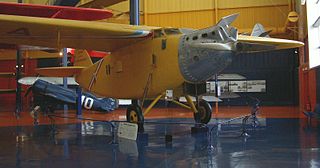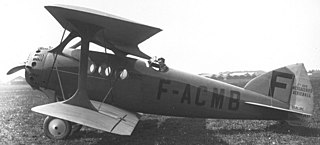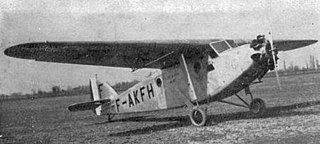
Potez 25 was a French twin-seat, single-engine sesquiplane designed during the 1920s. A multi-purpose fighter-bomber, it was designed as a line aircraft and used in a variety of roles, including fighter and escort missions, tactical bombing and reconnaissance missions. In the late 1920s and early 1930s, Potez 25 was the standard multi-purpose aircraft of over 20 air forces, including French and Polish. It was also popular among private operators, notably mail transport companies.

Between 1920 and 1951 the Société des Moteurs Salmson in France developed and built a series of widely used air-cooled aircraft engines.

The Bernard 190 or Bernard-Hubert 190 was a French airliner of 1928. It was a high-wing cantilever monoplane of conventional configuration, based on the Bernard 18. Compared with its predecessor, it kept the same basic design but featured redesigned tail surfaces, an enlarged cabin, and offered its flight crew a completely enclosed cockpit. Also like its predecessor, the basic airliner model provided the basis for a long-range aircraft to be used in record attempts, the 191GR.

The Bleriot-SPAD S.33 was a small French airliner developed soon after World War I. The aircraft was a biplane of conventional configuration whose design owed much to the Blériot company's contemporary fighter designs such as the S.20. Four passengers could be accommodated in an enclosed cabin within the monocoque fuselage, and a fifth passenger could ride in the open cockpit beside the pilot. A great success, the S.33 dominated its field throughout the 1920s, initially on CMA's Paris-London route, and later on continental routes serviced by Franco-Roumaine.

The CAMS 37 was a French 1920s biplane flying boat designed for military reconnaissance, but which found use in a wide variety of roles.

The Mauboussin M.120 was a trainer and touring aircraft built in France in the 1930s and again in the years following World War II.

The Caudron C.109 was a light utility aircraft built in France in the late 1920s.

The Farman F.200 was a civil utility aircraft produced in France in the 1930s. Derived from the F.190, it featured a revised fuselage that did away with its predecessor's enclosed cabin. Instead, it was a parasol-wing monoplane with open cockpits in tandem for the pilot and one or two passengers. Intended primarily as a trainer, it was also marketed as being suitable as a photographic platform or a mail plane.

The Farman F.300 and F.310 were airliners built in France in the early 1930s. They were high-wing strut braced monoplanes with fixed tailskid undercarriage with a trimotor layout popular with several manufacturers of the time. The cockpit and passenger compartment were fully enclosed. Most saw service in Farman's own airline, whose twelve F.300 variants made up half its fleet in 1931.

The Morane-Saulnier MS.147 and its derivatives, the MS.148 and MS.149 were a family of trainer aircraft produced in France in the late 1920s for civil and military use. They were derived from other machines in Morane-Saulnier's successful line of monoplane trainers, combining the wire-braced parasol wing of the MS.138 with the fuselage and undercarriage of the MS.130.

The SPCA 80 was a French transport monoplane designed by Société Provençale de Constructions Aéronautiques (SPCA) to meet a French government requirement for a single-engined colonial transport, specifically for police duties.

The Lioré et Olivier LeO H-180 was a 1920s French two-seat flying-boat built by Lioré et Olivier.
The ANF Les Mureaux 140T was a French postal monoplane first flown in September 1932. It was a high-wing monoplane powered by three 120 hp (89 kW) Salmson 9Ac radial engines. It had room for six passengers or four plus freight or mail but it did not enter production.

The SPCA 90 was a civil transport aircraft built in France in the early 1930s.

The SPCA Météore 63 was a flying boat built in France in the 1920s for use as an airliner. It was the first product of the SPCA company, founded by Laurent-Dominique Santoni when he left CAMS in 1925.

The SPCA 30, also known as SPCA Type III, was a French bomber aircraft built by the Société Provençale de Constructions Aéronautiques (SPCA).
The SNCAC NC.130 was a French high-altitude research aircraft of the 1930s. A single example flew in 1939, but was destroyed during the Second World War.

The SPCA 10 or SPCA Paulhan-Pillard E.5 was a large, all-metal, French reconnaissance and bomber flying boat flown in 1928. Only one was built, and it was lost in a fatal crash during development.
The SPCA 20 was a French seaplane designed for torpedo bombing. It was a low-wing monoplane of all-metal construction.
The SPCA 60T was a French transport seaplane built in the early 1930s. The SPCA 60T had a high-wing monoplane configuration with engines in tandem and all-metal construction.

















